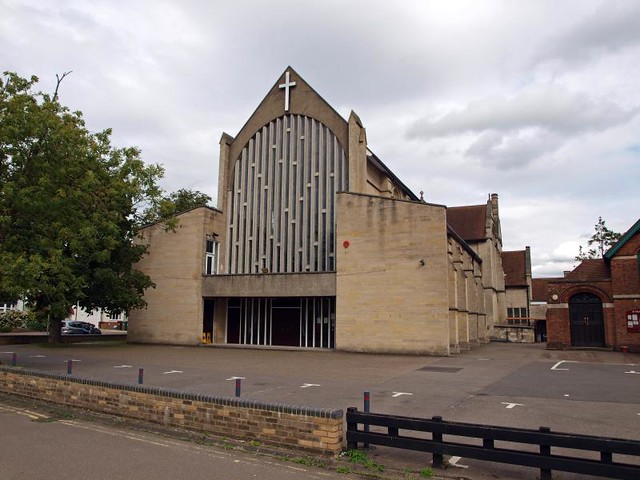An obvious oddity is the dedication since there are only six other churches in England (Falmouth, Newtown in Wem, Tunbridge Wells, Shelland and Plymouth, which is a bombed out ruin and stands as a War Memorial, which have this dedication.
The vicar responsible for building it, Allen Hay (incumbent 1898-1954), was a member of the Royal Martyr Church Union and it was proposed at the A.G.M. of that organisation that it would further the cause of the R.M.C.U., which had been founded in 1906 for the purpose of honouring the name of Charles I and to restore it to its proper place in the Anglican Calendar, if a new church was built and dedicated in his name.
Despite the bland, nay dull, exterior I rather liked the interior which has a very Catholic feel to it but that's due more to the build date than any high church tendencies. Having said that I wouldn't normally go out of my way to visit it.
Update: When I visited Potters Bar in January I missed St Mary the Virgin, lnk, so last week (21.08.14) I rectified this omission - I almost wish I hadn't.
No Pevsner.
POTTERS BAR. Beginning life as a hamlet of South Mymms, it has become a growing place and has seen in our time dire happenings, from its stand on one of the highest points of the Great North Road between London and York. Here stands an oak tree shorn of many branches by a sheet of fire; not lightning but a German Zeppelin struck it, the second in a month to fall flaming from the sky in sight of Potters Bar. One was shot down on September 3, 1916, by our VC airman William Leefe Robinson, the first Zeppelin to be brought down in England, and fell just over the county border at Cuffley. It was the second Zeppelin that hit this oak tree at Potters Bar a few weeks later, but the crews of both airships lie buried here in the new churchyard. Not one escaped from this terrible fate and hardly one was recognisable; and the inscription in their memory tells us that their names cannot be assigned to tombstones; they are written instead on 35 stone tablets on a wall marked with a black cross. Out of this holocaust has come a little gem, a crucifix fashioned from the twisted metal of the German airship that fell on English oak.
We may see this crucifix on an old altar table which is probably the oldest possession of the church, the church itself being one of the most beautiful modern buildings in the county. It is in 14th century style, strikingly lofty with long clerestory windows and fine tracery in the rest, arcades on clustered columns, and a chancel arch soaring to the great oak barrel roof of the nave and chancel. The windows have fine portraits of several saints and one window is a tribute to John Keble, having been placed here on his centenary in 1933. It shows him in white gown and gold vestments, with a picture of a little church and the words from one of his famous hymns. Under this we see him in wig and gown, preaching. A Madonna window showing her as a little girl in the Temple is in memory of Robert Goodacre, a schoolmaster here for a generation, and another has the figure of Randall Davidson, the Archbishop of Canterbury who was offered burial in Westminster Abbey but wished to lie in the cloister of his own cathedral. There is a brass inscription, with an angel at each end, to a vicar for 54 years of last century.
Not far away is a church built in Norman style 100 years ago but now forsaken; it is a desolate place. In striking contrast is another building here - Oakmere House, the home of the town council, with a lake in front of it and fine trees in its drive.

No comments:
Post a Comment